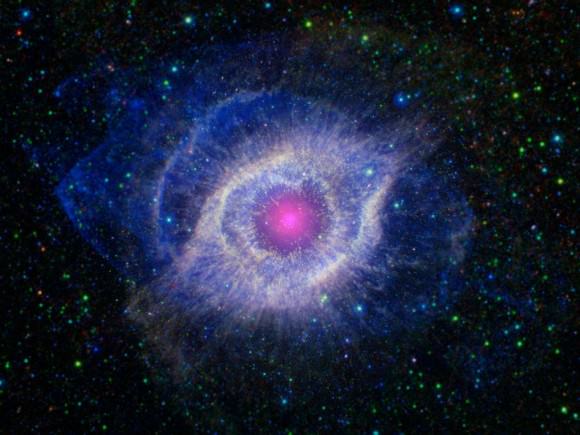
A combined image of the Helix Nebula from the Spitzer Space Telescope,the Galaxy Evolution Explorer (GALEX) and the Wide-field Infrared Survey Explorer (WISE).. Credit: NASA/Caltech
The Helix Nebula has been called the “Eye of God,” or the “Eye of Sauron,” and there’s no denying this object appears to be a cosmic eye looking down on us all. And this new image – a combined view from Spitzer and GALEX — gives a blue tint to the eye that we’ve seen previously in gold, green and turquoise hues from other telescopes.
But really, this eye is just a dying star. And it is not going down without a fight. The Helix Nebula continues to glow from the intense ultraviolet radiation being pumped out by the hot stellar core from the white dwarf star, which, by the way, is just a tiny white pinprick right at the center of the nebula.
The Helix nebula, or NGC 7293, lies 650 light-years away in the constellation of Aquarius. Planetary nebulae are the remains of Sun-like stars, and so one day – in about five billion years – our own Sun may look something like this — from a distance. Earth will be toast.
The team from the Spitzer Space Telescope and the Galaxy Evolution Explorer (GALEX) that cooperated to create this image describe what is going on:
When the hydrogen fuel for the fusion reaction runs out, the star turns to helium for a fuel source, burning it into an even heavier mix of carbon, nitrogen and oxygen. Eventually, the helium will also be exhausted, and the star dies, puffing off its outer gaseous layers and leaving behind the tiny, hot, dense core, called a white dwarf. The white dwarf is about the size of Earth, but has a mass very close to that of the original star; in fact, a teaspoon of a white dwarf would weigh as much as a few elephants!
The intense ultraviolet radiation from the white dwarf heats up the expelled layers of gas, which shine brightly in the infrared. GALEX has picked out the ultraviolet light pouring out of this system, shown throughout the nebula in blue, while Spitzer has snagged the detailed infrared signature of the dust and gas in red, yellow and green.
Where red Spitzer and blue GALEX data combine in the middle, the nebula appears pink. A portion of the extended field beyond the nebula, which was not observed by Spitzer, is from NASA’s all-sky Wide-field Infrared Survey Explorer (WISE).
JPL
Source: Universe Today
No hay comentarios:
Publicar un comentario